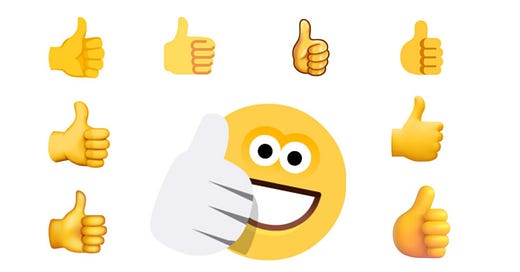According to 2,000 young adults (surveyed in 2021 by Perspectus Global), the thumbs up emoji is the top emoji that makes users look “officially old and past it.”
Many Gen Z’ers see the emoji as passive aggressive. In one Reddit post, a Gen Z’er wrote: “[At work when using Microsoft Teams,] I think it’s normal to ‘thumbs up’ messages, but I still feel like it’s such an unsettling response.” Another user wrote: “It’s super rude if someone just sends you a thumbs up.”
Maybe it seems like a cold, faceless response of approval, especially when compared to the multitude of other emoji options. Or maybe it just harkens back too much to the Facebook like button, a symbol of a social media platform that’s affiliated with older users. But, whatever it is, the 👍 is under attack by Gen Z –– in the best case, it’s seen as dated, and in the worst case, it’s seen as rude.
Just like with words (think: “woke” or “cool”), an emoji’s meaning can shift through time, even as its pictorial representation remains constant. This is why the 👍 could go from a sign of agreement to a sign of dismissiveness.
Consider, for instance, a text exchange between Irish Minister for Health Stephen Donnelly and Chief Medical Officer Dr. Tony Holohan. In October 2020, Holohan texted Donnelly to say the number of COVID cases in Dublin was increasing, advising him to be careful with public messaging. Later, Holohan texted Donnelly: “R for Dublin is up –– 1.2 to 1.3”. Donnelly responded: “👍”. These text messages were shared with the public, and there was an uproar around Donnelly’s use of the 👍 emoji. Some thought it was a curt and dismissive response to a serious message. But Donnelly said in a news interview: “It was shorthand for thank you. I think that’s what it is, that’s what I use it for, you know. It wasn’t a winky face.” Donnelly and Holohan are older men, and the public response was largely captured on Twitter, so this uproar illustrates the 👍’s generational divisevenss. The fact that the public’s interpretation of the emoji (curt and dismissive) differed from Donnelly’s interpretation (thank you) underscores how easily one symbol can carry multiple meanings, even within the same context.

The shifting meaning of the thumbs up gesture predates the emoji. In Ancient Rome, the sign was akin to raising the middle finger. According to classical studies professor Anthony Corbeill, the sign was used in gladiatorial combat to signal killing the gladiator. The thumbs up, then, might’ve been the worst gesture one could see in Ancient Rom.
However, by the twentieth century, the thumbs up was a sign of approval. The earliest written instance of the thumbs up as a positive gesture, according to the Oxford English Dictionary, was a 1917 book called Over the Top by Arthur Guy Empey. Empey wrote: “Thumbs up, Tommy’s expression which means ‘everything is fine with me.’” Of course, the gesture’s positive affiliation almost certainly predates Empey’s book, though it’s hard to know by how long. Nonetheless, sometime in the long gap between Ancient Rome and 1917, the thumbs up switched from a negative sign to a positive one.
In an October 16th op-ed in Forbes, journalist John Brandon noted that “if [emojis] are moving targets, it’s yet another form of communication we have to track, dissect, parse, and comprehend.” Brandon argued that “emojis should be safe and reliable, not contain any extra hidden meanings or implications.”
I think this argument is wrong. It assumes symbols are stable in their meaning, but they rarely are. The thumbs up gesture has gone from kill signal to approval sign, just as its emoji form has gone from positive support to passive aggressive.
The same sign has carried different meanings for different generations. And perhaps this isn’t surprising. Perhaps it’s only inevitable that a thumbs up –– a vague sign, so innately intertwined with one of our most anatomically distinguishing features (our thumbs) –– carries cultural significance.
Notes.
The Perspectus Global survey was conducted in coordination with Yahoo, with findings overviewed here.
The Gen Z reddit quotes are sourced from this article.
The Irish thumbs up debacle is detailed in this article.
A brief history of the thumbs up from Time Magazine is here.
John Brandon’s rather cranky op-ed in Forbes is here.





